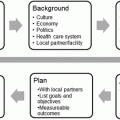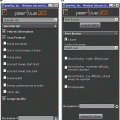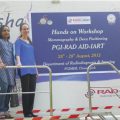Fig. 9.1
Leigh Giles-Brown, RAD-AID volunteer (center), provides group instruction on clinical sonography
Technologist volunteers should also be prepared to handle a situation in which there is a lack of technologist interest in the outreach initiative. It is often easy for volunteers to get caught up in the excitement of international outreach, and assume that their arrival within a host-imaging department will be met with enthusiasm and a warm welcome. However, local community members serving in technologist roles are often doing so not out of an interest in medical imaging but because they were assigned to these positions in an attempt to address personnel shortages within the host-imaging department. With this in mind, it is not difficult to understand how the sudden presence of a highly trained technologist counterpart, making recommendations on personal practice improvements, could come across as intrusive or threatening. However, in these same environments, academic standing often dictates the potential for an individual’s career advancement, and thus a potential solution to garnering technologist engagement may be the provision of a certificate of completion awarded to those who participate in educational initiatives. An achievement recognition strategy which includes certificates of completion may assist the technologist volunteer to motivate and engage local technologist personnel, encouraging them to take responsibility for their own learning and enhancing overall project success (Fig. 9.2).
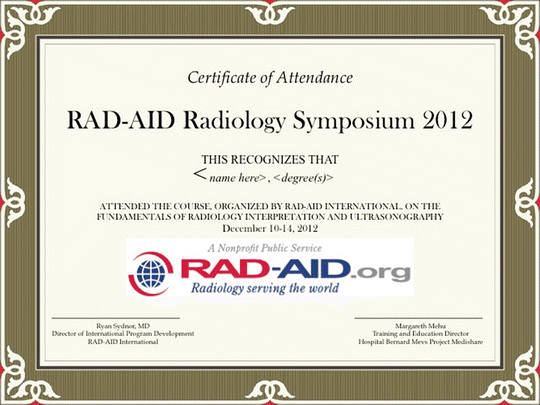

Fig. 9.2
Example of a RAD-AID certificate of completion that could be customized depending on instructional course audience and focus
In contrast to the above scenario, technologist volunteers may also find themselves working with local technologist personnel who are excited at the prospect of receiving training and educational assistance. In such situations, it is important to recognize that a successful outreach initiative involves not only the teaching of complex theories but also the role modeling of skills and attitudes related to optimal patient care. Technologist volunteers may be looked upon as examples of how the ideal technologist should act and often will find their behaviors, attitudes, and actions looked upon as standards for the profession. For this reason, it is imperative that technologist volunteers have a high level of confidence in their particular imaging modality, demonstrating well-honed clinical reasoning, effective decision-making, accurate documentation, as well as compassion in patient care interactions. Errors made by volunteers related to poor professional practice could potentially lead to a miseducation of the local imaging personnel and the creation of poor habits that can be difficult to break later without a great deal of confusion and frustration on the part of both the trainees and future volunteer educators.
Imaging Department Assessment
Serving as the member of the radiology team responsible for acquiring medical images within the developed world, the technologist volunteer is able to provide a practical and well-informed perspective to the project site assessment process. For example, an experienced technologist can go beyond simply counting the number of radiography or ultrasound units present within a department and assess whether the number of imaging systems available is adequate given the number of exams being performed by the host department. Furthermore, while most individuals would be capable of powering on imaging equipment, or even assessing the ability of the unit to produce an image, a technologist is in a position to evaluate the level of function of the system in question.
In resource-poor communities, there are rarely service contracts or service engineers available to correct equipment malfunctions. The local technologists are often relied upon to fill the void in technical support and develop custom solutions and “work-arounds” to keep imaging systems operational. In such scenarios, a skilled technologist volunteer is capable of assessing whether the equipment adaptation has adequately restored functionality or whether a more advanced repair is required to optimize the images being produced. Additionally, prior determination of the specific equipment make and model available within the host department will aid in adequate customization of potential lesson plans to be implemented (Fig. 9.3). The technologist volunteer is often also responsible for assessing whether the number of technologist personnel available is suitable given factors such as the department’s exam volume, the type of exams performed, as well as the typical patient condition. Having advanced knowledge of these details is key to developing educational initiatives that are student centered and customized for what the trainee needs to know rather than what the educator assumes they need to know.
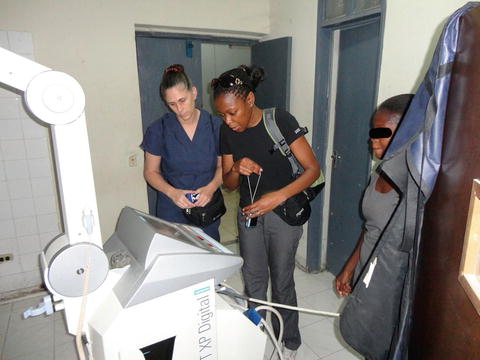

Fig. 9.3
Kristen Mitas and Kayiba Medlen represent RAD-AID during an on-site assessment of an imaging department in Haiti
A second benefit of pre-assessing the specific content areas in need of educational intervention pertains to the optimal selection of technologist volunteers, best suited to develop and implement such interventions. With no shortage in technologist volunteers interested in radiology outreach opportunities, decisions regarding volunteer selection should never be made with the assumption that all technologists can address tasks equally. For example, an imaging department may need assistance in enhancing the quality of their images that are processed with an analog (film-based) system. Sending a volunteer technologist who was not trained prior to the wide-spread introduction of digital imaging systems would be of little use in such a situation in which a strong understanding of film chemistry and development procedures is required.
When conducting an assessment of the host department’s technologist personnel, there are two initial decisions that need to be made. Namely, how the volunteer will determine which radiology content areas should be evaluated and the format the assessment will follow. When determining the content areas to be evaluated, it is best to use a standardized model that defines what a competent technologist would need to know in order to provide optimal imaging services. One recommended source is the American Society of Radiologic Technologist’s (ASRT) Curricula documents [7]. The aim of the curricula documents is to outline a common body of knowledge that is essential for entry-level technologists in various modalities of interest. Specific instructional methods have been intentionally omitted to allow for programmatic prerogative as well as creativity in instructional delivery. The authors of the document recognize that traditional technologies are still part of the fabric of many communities and subsequently are inclusive of various radiologic science topics such as clinical practice, image acquisition and display, image analysis, imaging equipment, human structure and function, patient care, ethics, and many others that are foundational to technologists practicing in all healthcare settings.
A combination of methods can be utilized as potential formats for evaluating the level of imaging knowledge and clinical skill set of local technologists. For instance, for projects in which detailed outcome measures are desired, a pretest/post-test assessment model may be utilized. However, despite the obvious benefits of taking a rigorous scientific approach to the personnel assessment, it is important to keep in mind that the use of examinations may come across as threatening to members of the host-imaging department. Such an approach could be potentially damaging to a collaborative partnership in the early stages of development. An alternative method for conducting an assessment of personnel is dependent on the technologist volunteer’s attention to detail and recording of personal observations regarding areas of improvement that are not readily apparent to members of the host-imaging department. For example, volunteers could recognize and note points of improvement regarding suboptimal patient positioning or a limited knowledge of anatomical landmarks. A third, and more direct, method of assessing for educational need is to simply ask the local staff or department head for recommendations of radiology content areas where they would like to see improvement, and in which potential lesson plans can be developed. It is well documented that individuals are more likely to commit to an activity to the extent that they have participated in planning of the activity [3]; therefore, an effective way to create dialogue about needed improvements is by first finding a common starting point and successfully completing agreed-upon project goals.
Stay updated, free articles. Join our Telegram channel

Full access? Get Clinical Tree



